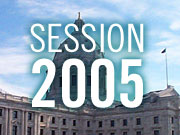Audio
Photos
More from MPR
| ||||||||||||||||||||||||||||||||||||
June 2, 2005
School district leaders are relying a lot on guesswork this year as they prepare their annual operating budgets. They still don't know how much state funding is headed their way. State law requires school boards to adopt local budgets by June 30. But state lawmakers have yet to pass an education finance bill, and their special session could drag on for weeks.
St. Paul, Minn. — St. Paul school board members are facing some tough decisions in the coming weeks. They're considering a plan to cut 180 jobs to help solve a $15.3 million budget deficit.
Declining enrollment and three years of flat funding from the state have taken a toll in St. Paul. School Board Chairwoman Elona Street-Stewart is waiting eagerly to know how much state funding the district will actually have to work with.
"This has put us in a very difficult circumstance, and the schools are waiting to hear from us," Street-Stewart says. "It's awkward to come to the table and still not yet know the decisions of the Legislature on our budgets. And it's not just St. Paul schools."
Districts throughout the state have had to make educated guesses on state funding. Some have assumed a worst-case scenario of no increase. Others are basing their budgets on at least a 2.5 percent increase on the basic per pupil formula.
That was the original spending proposal from Gov. Pawlenty. He's since raised his offer to 4.2 percent. The Minnesota House is pushing a 3 percent increase, while the Senate wants 5 percent.
Officials in the Burnsville-Savage school district are working on the expectation of a 2.5 percent increase. Even with that projection, they're still trying to close a nearly $2.5 million hole in the budget, which is partly the result of declining enrollment. Superintendent Benjamin Kanninen says his district has one option to try to minimize the impact of the cuts.
"We have a small fund balance remaining from past years. And in the event that the results from the Legislature are not very good, we plan to spend that money in its entirety for the coming year to keep our programs intact," says Kanninen.
Kanninen says a larger increase in state funding would allow the district to maintain current programs and teaching positions without tapping the reserves. He says it still won't be enough to restore the cuts made in previous years.
In other districts, officials will adjust their budgets to the additional revenue and try to bring back some of their laid-off teachers before school starts.
Brad Lundell is executive director of Schools For Equity in Education, a lobbying organization for school districts with lower property wealth. He says schools will be in a planning pinch if the Legislature takes the rest of the month to finish its business.
"Whichever way you're going, if you're cutting or you're bringing back, you're having to make adjustments that you have very little time to do," says Lundell. "It's not going to be a seamless transition to the new year, because of the timing in which folks are getting their budgets finalized."
Public schools are supposed to keep getting aid payments at the current funding level, even if lawmakers fail to reach an agreement on state spending by the end of the month.
Charles Kyte of the Minnesota Association of School Administrators says he fears that a partial government shutdown might still result in a delay of those payments. He says school leaders will get increasingly uneasy if they see no action at the state Capitol.
"As the month wanes on, if it looks more and more like we're going to end up without a settlement here, I think you're going to see superintendents and school boards having to revisit plans for making additional staff cuts, especially in the non-licensed areas," says Kyte. "We don't want that to be happening, but that's the reality as we get close to the end of June."
House and Senate negotiators continue meeting regularly to discuss their competing education finance bills. But the governor and legislative leaders appear no closer to resolving their larger budget impasse.








